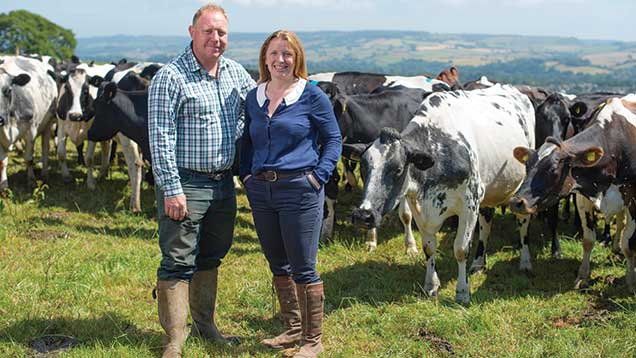Farmers Weekly Awards 2015: Dairy Farmer of the Year
 © Jim Wileman
© Jim Wileman Peter and Di Wastenage
Wastenage Farms, Budleigh Salterton, Devon
You could not find better examples of creating business opportunities out of dairying than this dynamic duo. Their impressive business plan for growth wowed the judges.
In a short period of time, and through a difficult recession, they have built up a thriving dairy business, which comprises 645ha and 1,090 cows across four units.
The aim of the game is to maximise profit on every litre of milk produced and clearly defined targets and real-time account monitoring each month help them meet these goals.
“We expected each unit to pay for itself. And if we can borrow money at 4-5% [interest] we would look for a minimum 10% return on investment,” explains Peter.
Farm facts
- Total of 645ha
- Running four herds totaling 1,090 cows
- Breeding their own replacements
- Running a NZ-style, extended grazing system
- Members of the South Hams Dairy Co-op
Simplicity is at the heart of their system and this philosophy has been replicated across the business with a New-Zealand style, extended grazing system on each unit.
Although they came out of organic production a number of years ago, the Wastenages have not lost sight of its benefits.
“Organic has allowed us to be proactive rather than reactive,” says Peter.
Targeting antibiotic use for cows with high somatic cell counts only is helping to keep vet and medicine costs at 0.5p/litre.
You would be proud to welcome any member of the public to their units at anytime of the year. Cows are kept outdoors all-year round and a great emphasis is placed on cow management and welfare.
They have 8m-wide tracks to improve cow flow and run a back-latch system so cows can walk to the milking parlour at their own pace.
Winning ways
- Impressive business acumen and growth
- Passion for the industry
- Development of staff and new entrants
- High profitability
Lameness stands at six cases per 100 cows and the 12-month rolling average for somatic cell counts is 118,000 cells/ml.
Their focus is firmly on profitability and they are making the best use of the cheapest resources available to them and monitor and record inputs meticulously.
Grass growth is recorded using plate meters and the grazing covers are tracked using farm software, which enables them to allocate grass appropriately while targeting nitrogen more efficiently.
By achieving a commendable 3,520 litres of milk from forage, they are able to operate at a cost of production way below the national average.
But Peter and Di do not believe farming and good environmental management go hand in hand, and go above and beyond when it comes to environmental stewardship.
As well as being part of agri-environmental schemes, 12 years ago they started reintroducing grey partridges, barn owls and hares back to their farms.
Their passion for dairying is infectious, but how they are channeling that enthusiasm into educating people outside of the industry is truly impressive.
When it comes to showcasing their farms they have an “open door” policy, hosting in excess of 500 visitors every year, from schoolchildren and local discussion groups to professionals.
Finalists
 Adrian Smith
Adrian Smith
Brookhouse Farm, Middlewich, Cheshire
Adrian runs a 200-head Holstein Friesian herd, yielding 8,557litres a cow annually. He is achieving an impressive 5,260 litres from forage alone. He’s a fantastic mentor for young people starting out in farming.
 Brian Yates
Brian Yates
Castle Douglas, Dumfriesshire
While smaller family dairy farms in Dumfriesshire are getting out of milk or getting bigger, Brian is getting better not bigger, by generating an extra 6p/litre income by selling heifers from his 250-head Holstein pedigree herd.
Sponsor’s message
“Congratulations to Peter and Di. Their business model and dedication to both their staff and future farming generations is a sign of true champions.”
Michael Keogh, marketing manager, Ireland and UK

